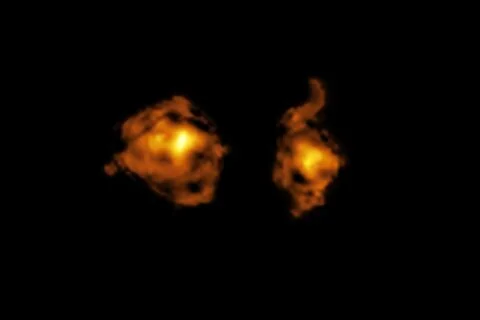
‘Cosmic Joust’: Astronomers Witness Galaxy Collision 11 Billion Light-Years Away, Black Hole Radiation Disrupting Star Formation
For the first time, astronomers have observed a spectacular cosmic event: a high-speed collision between two galaxies, dubbed the "Cosmic Joust," occurring 11 billion light-years from Earth. This rare observation provides a direct glimpse into how quasars, some of the universe's most energetic phenomena powered by supermassive black holes, can drastically influence the evolution of galaxies.
The findings, published in the journal Nature, detail how the galaxy hosting a bright, actively feeding black hole (a quasar) is spearing its neighbor with intense radiation, disrupting its ability to form new stars. According to Pasquier Noterdaeme, a researcher at the Paris Institute of Astrophysics, the two galaxies are charging towards each other at a staggering 1.2 million miles per hour.

Using the Atacama Large Millimeter/submillimeter Array (ALMA) and the Very Large Telescope (VLT) in Chile, the team was able to distinguish a second galaxy, revealing that it is being bombarded by radiation from the quasar. This radiation is so intense – about a thousand times stronger than the radiation of our Milky Way – that it splits and disperses hydrogen molecules in the victim galaxy's star-forming nurseries.
Sergei Balashev, a researcher at the Ioffe Institute in Russia, explained, "We see for the first time the effect of a quasar's radiation directly on the internal structure of the gas in an otherwise regular galaxy." He added that the gravitational forces at play are also pulling more gas toward the black hole, further fueling the quasar and its disruptive effects.
How does this 'cosmic joust' work? The quasar, essentially a supermassive black hole rapidly consuming matter, emits powerful jets of radiation. When this radiation hits the neighboring galaxy, it inhibits star formation by dispersing the dense gas clouds necessary for new stars to form. The process resembles a “switch off” mechanism for star birth in the affected galaxy.
The discovery offers a rare look into the early universe, where galactic mergers and highly dynamic quasars were more frequent. Dong-Woo Kim, an astrophysicist with the Harvard and Smithsonian Center for Astrophysics, noted that while galaxy mergers still happen, the universe was more densely packed billions of years ago. Even our own Milky Way is expected to merge with the Andromeda galaxy in a few billion years.
Scientists believe this research will provide more insights into the birth and evolution of galaxies. This first-time direct observation opens new avenues for understanding the intricate interplay between quasars and their galactic environments.
What are your thoughts on this mind-blowing discovery? Share your theories and perspectives in the comments below!